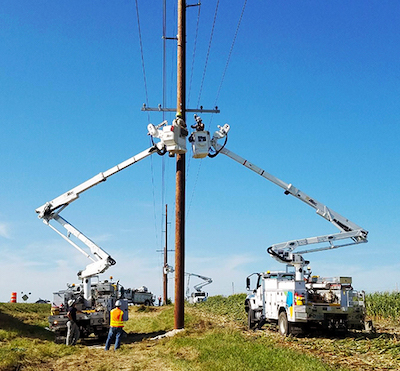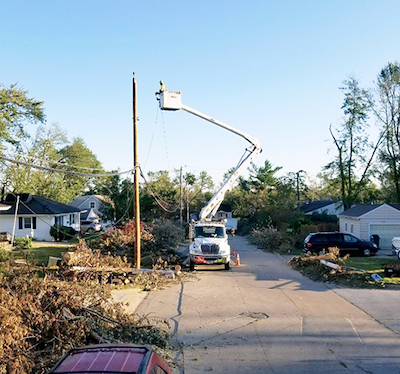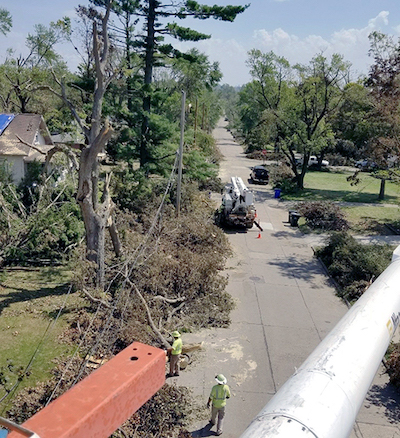Early weather forecasts for Iowa on Aug. 10 called for run-of-the-mill summer thunderstorms. But by midday, Cedar Rapids Local 204 Business Manager Dustin Stumma knew things had changed dramatically.

|
|
Even with countless storm-chasing IBEW lineworkers occupied with post-hurricane cleanup along the East Coast, Cedar Rapids, Iowa, Local 204 was able to recruit more than 1,000 other lineworkers from throughout North America to help out after the August 10 derecho.
|

|
|
The effort to get power restored to an estimated 2 million customers following the August 10 derecho sent an IBEW line crew to just about every street corner in the affected areas.
|

|
|
Cedar Rapid, Iowa, Local 204 lineworkers quickly assessed the damage caused by the derecho that ripped through the state on August 10.
|
“We started getting reports of bad weather and nasty damage north of Des Moines,” Stumma said. “I was over at our lawyer’s office in Cedar Rapids to talk about an arbitration when this thing hit us.”
It turned out that the weather system that had developed out of South Dakota the day before had been strengthened by the summer’s heat into a derecho—a long band of fast-moving, hurricane-force wind—by the time it reached the Hawkeye State.
While at the lawyer’s office, the city’s outdoor weather sirens went off, and that’s when Stumma checked the weather radar on his smartphone. “Holy cow, this thing is massive and it is moving fast,” he recalled thinking.
Through the office’s windows, Stumma started seeing tree branches snapping off and debris flying around. “I’ve seen tornadoes, but I’ve never seen anything like this,” he said.
The National Weather Service described the derecho as “a well-organized and long-lived complex of storms” that caused widespread wind damage across Iowa as well as northern Illinois and northern Indiana, with some reported wind speeds between 60 and 75 miles per hour.
After sheltering in place at the lawyer’s office until the storm moved east, Stumma drove north to Local 204’s office in Hiawatha, a normally short drive that wound up taking more than an hour and a half. “Transmission and distribution lines were blown over, water and branches were everywhere,” he said. “It looked apocalyptic. No matter where you went, there was destruction, like after a tornado, but a slow-moving one that destroyed everything for miles around.”
Once he reached Hiawatha, he couldn’t get in touch with any of his 1,500 members. “There was no power at the office, and cell services were down,” he said.
Within hours, though, communications were gradually restored and Local 204 lineworkers with Alliant Energy, Iowa’s main electrical utility, and Utility Lines Construction Services, the workforce with ITC, quickly headed out to assess damage and begin recovery efforts, even as they worried about their own derecho-damaged homes.
Serious injuries from the storm were limited, fortunately, and only two deaths in Iowa were blamed on it. Iowa’s governor estimated that nearly 8,300 homes were either severely damaged or destroyed, with about $23.6 million worth of damage to public infrastructure.
Getting things fixed was going to require lots of outside help, but unfortunate timing had the derecho hitting Iowa just as hundreds of storm-chasing line-workers were dealing with destruction caused by Isaias, first a hurricane and later a tropical storm that had moved along the East Coast from Florida to New England from July 30 to Aug. 4.
As a result, Alliant at first told Stumma that, “because we can’t find anybody, we’ll have to use nonunion resources,” he said. The energy company, however, had underestimated IBEW members: Stumma was able to pull in more than 1,000 lineworkers from other parts of the U.S. and Canada. “We did get a few nonunion workers, but they were the first to be released,” he said.
Challenging recovery efforts was the ongoing response to COVID-19. “We had to get people together to strategize,” Stumma said. “It was hard to social distance, but you’d keep your distance as much as possible and wear masks.”
Even though the long workdays could be grueling, they helped take workers’ minds off the coronavirus, Stumma said. “We almost forgot we were in a pandemic,” he said.
With an estimated 2 million customers without power at one point, it took two weeks to get the vast majority of them back online, an effort that sent an IBEW line crew to just about every street corner in the affected areas.
“There might be a crew where each person has a different home local,” Stumma said. “Seeing that made for very proud moments. We’re really thankful to everyone who came in to help out.”
The Cedar Rapids Gazette reported that lineworkers installed 3,400 new power poles and 400 miles of electrical cabling in that city alone. Stumma noted that the IBEW members working in Alliant’s Stores and Dispatchers groups, coordinating crews and distribution of those supplies, were crucial in making recovery possible. But that could have been a separate disaster, he said: “About a year ago, Alliant started eliminating in-house stores positions down to 13 and outsourcing the rest.”
The company brought back a few of the stores workers who had their previous positions eliminated for temporary derecho duty, but other temps had no stores experience at all. “If there was ever a silver lining to the derecho, it exposed the failure of outsourcing those stores jobs,” Stumma said.
Meanwhile, at NextEra’s Duane Arnold nuclear energy station, “some of our members also worked 16-hour days,” Stumma said. The plant had been set to begin decommissioning on Oct. 1, but the derecho “obliterated” a 40-foot cooling tower at the facility, which caused the company to begin the plant’s shutdown immediately. “Even though they knew they were losing their jobs soon, they still did the work,” Stumma said. “When times are at their worst, our members are at their best.”
While things are essentially back to normal in Iowa now, Stumma predicts that future weather events will expose lingering yet hidden derecho damage. “We’ll probably be chasing outages for years to come,” he said.